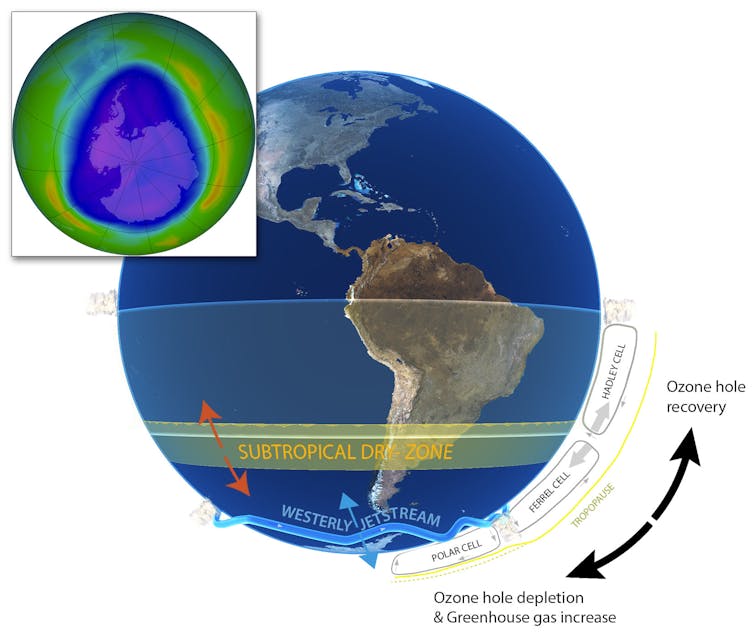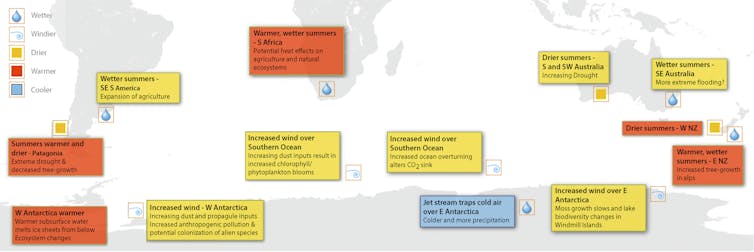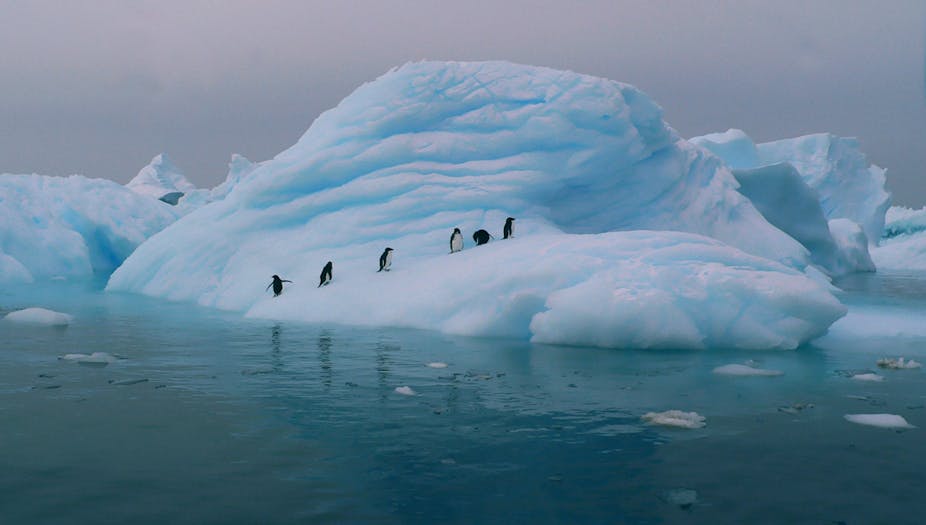Many people think of sunburn and skin cancer when they hear about the ozone hole. But more ultraviolet (UV) radiation isn’t the only problem.
The ozone hole has also led to dramatic changes in Southern Hemisphere weather patterns. These in turn are altering natural ecosystems and food production. These climate changes are likely having a similar if not greater impact than more UV radiation.
We discuss some of these changes in a paper published today in Global Change Biology.
This week the parties to the Montreal Protocol will meet in Paris, to consider the latest report from the United Nations Environment Programme Environmental Effects Assessment Panel. This report summarises the impact of both ozone loss and the associated increase in ultraviolet radiation on the environment and human health.
The Montreal Protocol continues to be effective at phasing out ozone depleting chemicals and has decreased levels of these greenhouse gases in the atmosphere. But while the Montreal Protocol is a success story, the Southern Hemisphere still faces the threat of climate change from rising greenhouse gases. There is still much to do.
Changing the weather
In recent years, climate scientists have shown that the ozone hole has had a profound impact on weather systems throughout the Southern Hemisphere, especially during summer.
The ozone hole has pulled the polar jet stream further south, increasing its strength. These winds isolate Antarctica and help to keep most of it cold as the rest of the world warms. This has prevented sea ice melt and rising sea-levels.

By changing atmospheric circulation, the ozone hole modifies wind, rain and snowfall patterns across the Southern Hemisphere. The changing pattern and strength of winds has caused shifts in the regions that get plenty of rain or snowfall, and those that stay dry. For example, the tip of South America is getting dryer but further north there is more rain.
Since water is vital for all living things, these changes could have profound effects on agricultural and natural ecosystems across the Southern Hemisphere. The ozone hole has been linked to better growth of trees and crops in areas where there is more rain, such as in south east South America and the New Zealand alps, whereas there is less growth in areas that have less rain or snow including trees in Patagonia and mosses in Antarctica.
In East Antarctica lake biodiversity has changed as lakes become saltier, due to less freshwater entering the lakes.
Stronger winds also change how the oceans mix — and this affects ocean productivity, and the ability of the Southern Oceans to take up CO2. The winds carry dust and can bring about blooms of phytoplankton (microscopic ocean algae) if more nutrients are transported into the ocean. Dust blowing into Antarctica could also bring spores of new species, to compete with the existing vegetation.
The effect of the ozone hole on weather patterns is most pronounced in summer and may also be responsible for more extreme events including floods, drought and wildfires throughout the Southern Hemisphere. Given that these extreme weather events affect water supplies, there may be many as yet unreported side effects of ozone depletion on ecosystems, ecosystem services and agriculture.

A world avoided
The Montreal Protocol (1987) is a major success story. As a result of this international agreement, the ozone hole is likely to recover by the middle of this century.
Ultraviolet (UV-B) radiation damage to all living organisms, including humans, has been minimised since the region where major ozone depletion occurred is over the sparsely-populated Antarctic. Even there the impacts on terrestrial life are thought to be small, probably less than a 6% loss in productivity in plants.
By controlling the release of ozone depleting chemicals the Montreal Protocol has made a large contribution to reducing greenhouse gases.
The world is cooler now than it would have been without the Montreal Protocol’s controls on emissions of ozone depleting chemicals. This is because many of the chemicals that break down ozone are also potent greenhouse gases (such as chlorofluorocarbons — CFCs).
Climate change in the Southern Hemisphere can be attributed to ozone depletion, as well as increasing greenhouse gases. Decades after the ozone hole was identified and action was taken, we are still discovering how profound its implications are both in terms of the “world avoided”, and unanticipated climate change.
Prompt action was taken in 1987 but the lag time for recovery is still long (see also here).
The Montreal protocol is an important lesson to us, both of the efficacy of international action and also the importance of timely responses to recognised climate change.
Sharon Robinson and Dr. David Erickson, Oak Ridge National Laboratory, USA present this work in the scientific journal Global Change Biology. They are both members of the UNEP-EEAP.

